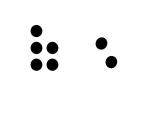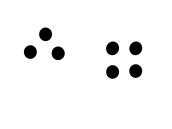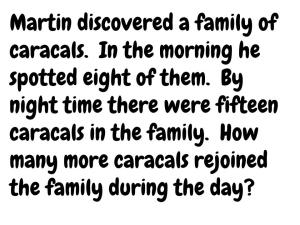
For the first episode of Math Talks I used my daughter, Lilly, as my student. She tends to be my educational guinea pig for many, many things. Lilly is entering first grade but thinking about numbers more like a second grader.
Here is a breakdown of the discussion:
The talk begins with a dot pattern image flash. This is an activity that helps kids to subitize (recognize quantities without counting). I started with this activity for two reasons. First, as a warm up and a way to get going. More importantly, I did it to reinforce the question I posed later. I wanted her to think about the ways to make 7 so my dots were different patterns of 7 (six and one, three and four, five and two). Later I was going to ask her to try to think about 7 as a group of two and five more so I knew this activity would get her thinking in this way.
When I explain the activity to Lilly, she immediately asks how fast I’ll flash the dot cards. You might notice my misspeak as I tell her that it won’t be so fast that she can’t see them and then I meant to say, “. . . but not slow enough that you can count them.” It is important that kids understand the idea isn’t to count the dots. They idea is to either immediately know the quantity (sets up to five) or to visualize the picture of known quantities and combine them (i.e. see two and two and two and one and that’s six and one more and that’s seven).
An important part of this section of our math talk is the follow up questions I asked. By asking her how she saw the dots and how many, it confirms and cements the idea that the total can be thought of as two parts combined.
As we get into the meat of the talk, I made sure to write my math story in a context that was interesting. Lilly’s show of choice this summer was Wild Kratts so I used that as a hook to get her interested and engaged. The question I posed was an add to, change unknown problem. That’s teacher speak for an addition word problem in which one of the addends (the quantity you are asked to add to the first quantity) is unknown but you know the first addend and the total. This problem is trickier than when you known both addends because you have to count up or add up to the total and attend to how many it took to get there. This is a problem first graders should have skill with by the end of the year.
What you see in the video is a visual of her thinking process while solving. I used the Show Me app to record her steps and did so after our discussion. It’s important to note that what you see is an exact match of what she wrote on her paper. After our talk, I spoke with Lilly about what she saw in her head when she was solving problems like this. She shared that she is thinking in numbers rather than in pictures. While that is good, and where she should ultimately be thinking, it is important that she have the ability to work with a picture model as well. In future talks, I’ll work on modeling her thinking with a picture and relate it to the number models with which she is comfortable.
We wrapped our talk with a discussion about challenge. This summer I’ve spent a lot of time learning about growth mindset. I really want to instill in my child, and others for that matter, the importance of attempting challenge, using mistakes as opportunities to learn and the value of effort. I’m doing that by emphasizing those qualities in the praise and feedback I give.
Here is the podcast and the youtube video is below. Enjoy!
For more Math Talks, visit the Math Talks page on the menu bar.



